

Geography & Geology For Kids - By KidsGeo.com.
Natural Hazards. Reykjavík: the geothermal city that aims to go carbon neutral. Reykjavík used to be marketed as a place of “pure energy”, run on geothermal power – and now Iceland’s capital is trying to become the world’s first carbon neutral city.
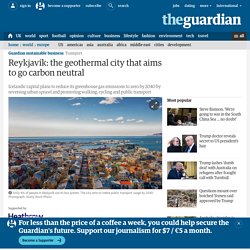
Last month, Iceland became one of the first countries to ratify the Paris climate deal with a unilateral parliamentary vote, shortly after Reykjavik announced its aim to be carbon neutral by 2040. It wants to reduce its greenhouse gas emissions from 2.8 tonnes per person in 2013 to zero – largely by changing the shape of the city to reverse urban sprawl and encouraging Icelanders out of their beloved cars to walk, cycle or use public transport. The city already has a head-start thanks to its reliance on geothermal energy. The biggest cause of global warming that nobody’s talking about. LAST UPDATED: 21 August 2015 Even if Prime Minister Tony Abbott hasn’t come around to the idea yet, most of us would agree that if we want planet Earth to sustain life for generations to come, we need cleaner energy.
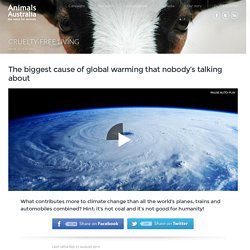
We need cleaner energy to fuel our cars, our homes, our cities… If advances in green tech can overcome these challenges, we will have solved a big piece of the climate puzzle. But not all the big pieces… What about the energy we use to fuel our bodies? Pumpkin media - Recherche Google. Introduction to Coastal Processes and Geomorphology, Second Edition: Amazon.co.uk: Gerd Masselink, Michael Hughes, Jasper Knight: 9781444122404: Books. More than 15,000 homes hit by winter floods, says LGA. Image copyright PA More than 15,000 homes and businesses in just eight council areas were flooded in last winter's storms, a survey has revealed.
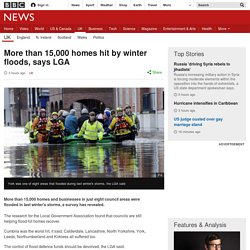
The research for the Local Government Association found that councils are still helping flood-hit homes recover. 100 countries push to phase out potentially disastrous greenhouse gas. A loose coalition of more than 100 countries, including the US and European nations, is pushing for an early phase-out of hydrofluorocarbons (HFCs), a powerful greenhouse gas that if left unchecked is set to add a potentially disastrous 0.5C to global temperatures by the end of the century.
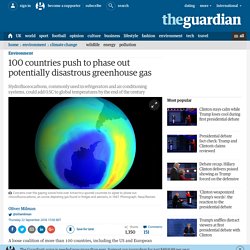
At a meeting in New York on Thursday, world leaders called for an “ambitious phase-down schedule” for HFCs, which are commonly used in refrigerators and air conditioning systems, and pledged adaptation money for developing nations where HFC use is rapidly increasing. “The growth in some HFCs is extraordinarily fast right now so it’s critical that we have an ambitious agreement,” a White House official told the Guardian. “This is an extraordinarily important opportunity.” Concerns over the gaping ozone hole over Antarctica spurred countries to agree to phase out chlorofluorocarbons (CFCs), an ozone-depleting gas found in fridges and aerosols, in the 1987 Montreal Protocol. Apparent polar wander. Apparent polar wander (APW) is the perceived movement of the Earth's paleo-magnetic poles relative to a continent while regarding the continent being studied as fixed in position.[1] It is frequently displayed on the present latitude-longitude map as a path connecting the locations of geomagnetic poles, inferred at distinct times using paleomagnetic techniques.
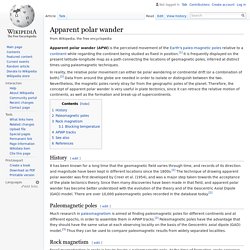
In reality, the relative polar movement can either be polar wandering or continental drift (or a combination of both).[2] Data from around the globe are needed in order to isolate or distinguish between the two. Nevertheless, the magnetic poles rarely stray far from the geographic poles of the planet. Therefore, the concept of apparent polar wander is very useful in plate tectonics, since it can retrace the relative motion of continents, as well as the formation and break-up of supercontinents. History[edit] Paleomagnetic poles[edit] Carbon emissions 'postpone ice age'. Image copyright Ittiz The next ice age may have been delayed by over 50,000 years because of the greenhouse gases put in the atmosphere by humans, scientists in Germany say.
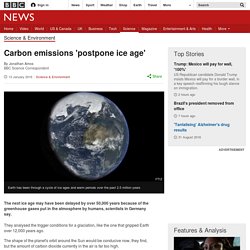
They analysed the trigger conditions for a glaciation, like the one that gripped Earth over 12,000 years ago. The shape of the planet's orbit around the Sun would be conducive now, they find, but the amount of carbon dioxide currently in the air is far too high. Earth is set for a prolonged warm phase, they tell the journal Nature. "In theory, the next ice age could be even further into the future, but there is no real practical importance in discussing whether it starts in 50,000 or 100,000 years from now," Andrey Ganopolski from the Potsdam Institute for Climate Impact Research said.
Soaring ocean temperature is 'greatest hidden challenge of our generation' The soaring temperature of the oceans is the “greatest hidden challenge of our generation” that is altering the make-up of marine species, shrinking fishing areas and starting to spread disease to humans, according to the most comprehensive analysis yet of ocean warming.
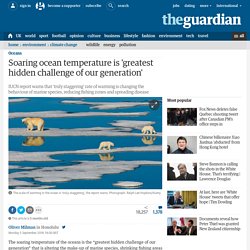
The oceans have already sucked up an enormous amount of heat due to escalating greenhouse gas emissions, affecting marine species from microbes to whales, according to an International Union for Conservation of Nature (IUCN) report involving the work of 80 scientists from a dozen countries. The profound changes underway in the oceans are starting to impact people, the report states. This Robot Could Make Exploring Oceans Deeper, Faster, and Cheaper. Wendy Schmidt couldn't contain her grin as she watched the robot rise from the bottom of the saltwater tank at the Monterey Bay Aquarium Research Institute in Moss Landing, California.

It was the first test run of SuBastian, her custom-built remotely operated vehicle (ROV). The underwater robot belonged to the Schmidt Ocean Institute (SOI), a nonprofit organization that Schmidt co-founded with her husband, Eric, executive chairman of Alphabet, Inc.